Introduction
I always like the idea of cycling, to effectively harness one’s physical energy for personal commuting. The joy of freedom and the sense of achievement amplified when the cyclist reaches his destination, achieving the same objective as driving an internal-combustion-engine vehicle, to school and for work. So I decided to tabulate my data, to see how much I had helped save environment. I found out if I had drove the same distance, I would have contributed more than 3 tonnes of CO2 to the environment in 6 years.
Short video with my vintage road bike:
Methodology
I have.. a few bicycles, each for a different purpose, for commuting and for race. I swapped the speedometer around different bikes so I can get the total distance recorded. Back then I was not six-sigma trained yet, so I collected minimal data to plot an estimated riding behavior. A lot of data are missing though.
In between I explored the idea of traveling with bicycle on MRT. Only the cycling distance is recorded, the MRT traveling distance is not taken into account.
Emission calculations
By the end of my active 6 years cycling activities, with 20440.5 km, mostly for commuting and not for leisure, okay my commuting is my leisure by the way. Most internal combustion engine (ICE) cars has a local CO2 emission rate of about 120 g/km for tank-to-wheel (http://www.carpages.co.uk/co2/co2-121-to-150-1.asp). Assuming 30 g/km for well-to-tank, I use 150 g/km for well-to-wheel for my calculations. Saving more than 3 tonnes of CO2 if I drove.
Considering diesel, well-to-wheel, that’s 271.54 g/km (http://www.hannover.de/klimaschutzallianz/data/download/emissionsfaktoren.pdf). I would have saved more than 5 tonnes of CO2.
Mileage and events
Plotted the graph during 6 years of my most active bicycle commuting, I’m most actively recording data in the 3rd~4th year, as I was using the commuting time to train for races. Numbers labelled with particular events:s
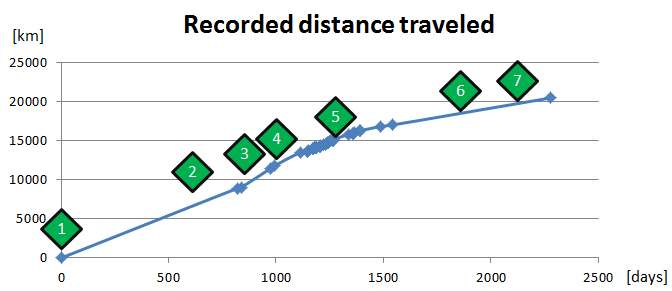
Events:
<1> Bought my first road bike before national service, the bike was 21 years old when purchased, classic Italian steel frame. About 16 km to ride to camp. Nights-off I would just ride home and back camp to sleep.


<2> ORD, entered university, that’s 22~24 km to school, but not everyday.
<2.5> Bought a 1.5 m long bicycle bag, explore the idea of dismantle bike and travel on MRT.
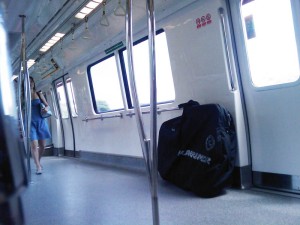
Note: From my place to university, straight bus takes about 1.5hr, bus-mrt-bus takes slightly less than 1 hour, cycling takes 1 hour (or less when I am fit), and cycling-mrt-cycling takes consistent 50min, fastest of all!
<3> Bought a foldable Dahon mountain bike, converted to street tyre and roadie-style handlebar.

<4> The third bike I tried for fitting in the bag for MRT is my vintage mountain bike that I used for Safra Adventure Race.
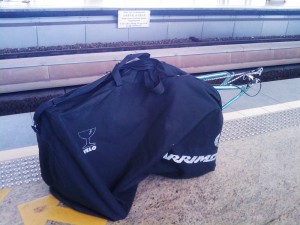
<5> In between, I changed accomodation location, different travelled distance each day, longest being 14 km everyday, was my most active period, trained joined different disciplinary races.
<5.5> SMRT train was vandalised by graffiti artist Oliver Fricker, humiliated, SMRT strengthen rules to bring bicycle on train. It was flag day which I cycled to Pasir Ris to raise donations. I wanted to take the train back to my university with my big bag of dismantled road bike, however I was stopped by the security for irregular bag size. I argued that the train is empty! We came to agreement to ‘let me go this time’ but not next time. With picture proof :

I understand that there’s rules for everything in Singapore, and employees know not how to think, but to follow the rules, even though the train is clearly empty. So if the bike is larger than the allowable size, it’s rejected (bullshit, I never seen them measure the size of guitar, oversize cello and luggage, they stopped me only because it’s a bicycle). Anyway I was very disappointed.
<6> Graduated, bought a China-version of Strida, one of the most compact foldable bike, required some small modification to fix some safety issue for the China quality, for bypassing the $*!@&#$ MRT rules for small foldable bike. No speedometer was installed, and it’s a pretty bad riding experience, but perfect for MRT (comes with a crappy bag as well).
<7> Switched job at another university, that’s 33 km one way distance, attempted less than 10 times to cycle to work before I switched to motorcycle.
I went to Germany for work, and had a very positive cycling experience there:
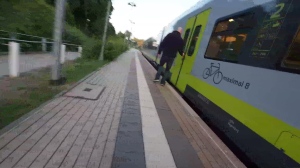





Conclusion
Singapore is somewhat on the right-track of promoting clean transportation, solving first/last-mile problem of commuting to MRT station. However cyclists in Singapore faced the following problems:
1) General lack of integrity, expensive bikes are unsafe to park anywhere (even at home, I heard about bikes getting stolen parking inside landed property).
2) Lack of sheltered parking and available lots at stations.
3) Lack of respect from other road users and fighting for space on pedestrian path and road. I had be horned by drivers even for keeping left to the curb, while some elderlies on trishaw riding on the right lane without anybody disturbing them. A cyclist friend of mine passed away from a hit-and-run lorry driver, would he had stopped when he first hit and not ran him over, my friend would’ve lived.
4) I like the sunny weather, but majority of my friends are disagreeing with me because of the humidity. It wasn’t exactly a comfortable area for daily cycling commuting.
5) Lack of support from public transport infrastructure.
Grass maybe greener the other side, as all the existing ‘problems’ are not existing in other places (Tokyo you can park a S$4k Cannondale lefty outside a restaurant without lock safely, Europe you can bring bikes on subways, California you can even bring bikes on bus). I couldn’t find enough data to show how many percent of residents are traveling on bicycle, I do understand there’s less than 10% of people are not relying on either motorised vehicle or public transport (http://www.singstat.gov.sg/publications/publications_and_papers/GHS/general_household_survey_release2/chap1.pdf). If 10% of the population cycles for commuting instead of driving, in 6 years we could’ve saved up to 15 million tonnes of CO2. If more people can recognise the benefits of bicycles, we can potentially cut down enormous emission, save money and even save time in some cases.



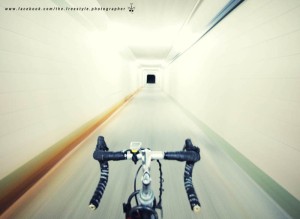
A nice and refreshing read. Thanks.
World is cooling since 1998. Sun activity drives climate and it is less active, heralding the Landscheit Minimum Period? But I used to love cycling, when I was active.
https://www.facebook.com/groups/ElectricUniverse/
We have the same problems in Brazil! But luckily with a lot of movement from the ciclists, we are slowly getting more attention…
I do hope everybody changes in a few years. I am, like yourself, a photographer who uses bike to go around 🙂